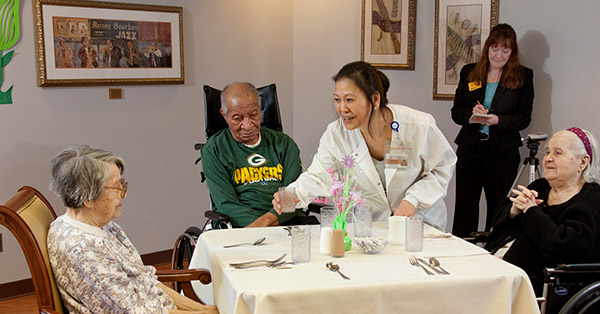
“Shhhhhhhhh.”
Bringing down the noise level isn’t quite as easy as putting a finger to the lips to shush people, but a University of Wisconsin-Milwaukee researcher is discovering ways to bring down the mealtime noise levels in nursing homes.
“I’m interested in the relationship between sound and psychiatric behaviors – like agitation – in people with dementia,” Laura Joosse says.
She will be presenting the results of her research pilot project on reducing nursing home noise levels at the Wisconsin Alzheimer’s Association meeting May 4.
Joosse, an assistant professor of nursing, became aware of the possible links between sound and agitation when helping care for her father, who was in the early stages of dementia before his death. “He seemed to become more agitated with too much sound stimulation,” she remembers.

Her doctoral dissertation focused on the impact of a noisy environment on nursing home patients suffering from dementia.
Ongoing loud sound can contribute to anyone’s stress levels, she explains. However, noisy situations may be particularly troubling to those who don’t totally understand what is aggravating them and have little control over their environment. In addition, she notes, the sound levels and increased agitation among patients may also contribute to staff stress levels. “It can be a cumulative impact of high sound levels throughout the day,” she says of the link between noise and behavior issues.
A noisy duet: symphony & silverware
Joosse’s theory is that turning down the noise levels, particularly at meal times, may help decrease the agitation of patients with dementia in nursing homes significantly.
“Meal time is one of the loudest times of the day in a nursing home. With meals three times a day that’s a major percentage of an individual’s day,” she notes. Working with two area nursing homes, she began studying if the mealtime volume could be dialed back.
It wasn’t as simple as having caregivers say “shhhhhhh,” but she did find several steps that could lower the mealtime noise levels, and developed a pilot project with the two homes to develop and test a “noise abatement protocol. “
First, she measured the decibels at mealtime in dining areas and identified sources of sound. She then worked with caregivers to figure out ways to change mealtime processes to keep the noise down. Finally, she helped each organization develop a plan that worked for their caregivers to lower the decibels
Two of the biggest contributors to mealtime noise levels, she found, were background music and the process of setting up and cleaning up the meal.
Some nursing homes play the music very loud; that’s perhaps because of the underlying stereotype that everybody who’s old is hard of hearing, notes Joosse. For example, she found music sound levels as high as 72 to 74 decibels during mealtimes, when at 60 decibels it becomes hard to hold a conversation. While the louder music might make sense during music therapy time when residents actually wanted or needed to hear the music, she says, during mealtime it just added to the overall noise. By turning down the music, not only were noise levels reduced, but residents were able to communicate better with each other, she adds.
Down with decibels
The other big factor in mealtime noise levels was the clinking, clanking and banging involved in setting up and clearing tables. The caregivers worked with her to figure out a different process that lowered the sound – setting the tables before residents arrived for lunch, and clearing them after they’d left the dining room.
With training and mentoring, caregivers at the two homes also became more aware of actions like slamming cupboard doors that might contribute to overall noise. No one was doing anything deliberately to annoy anyone else, says Joosse. “When you’re serving 40 or 50 people, you’re looking for efficient ways to do things, but not realizing how much the sound of set-up could upset some residents.” In addition, the sound levels and increased agitation among patients may also contribute to caregiver stress levels.
At the end of the pilot project, both homes had reduced their mealtime sound levels significantly. Anecdotal evidence from caregivers also indicated that general anxiety levels and agitation among the residents were down. And caregivers said they felt better as well. One caregiver said: “I don’t leave work with a pounding headache anymore.”
A next step in her research, Joosse says, is a study to examine the correlations between sound and changes in behavior among those with dementia.
“They (the residents with dementia) can’t tell us what’s bothering them so we have to figure out ways we can help.”







